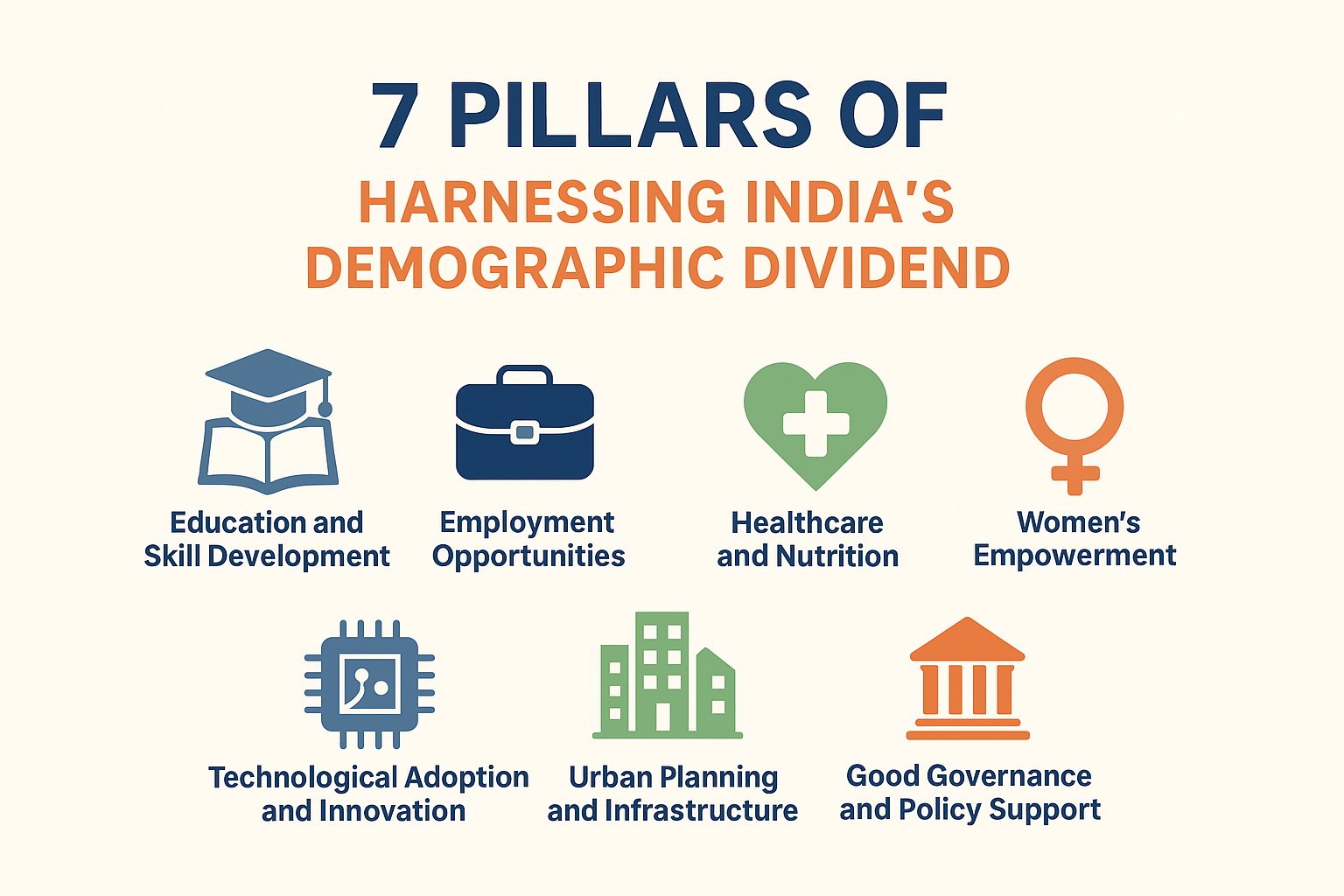India, with over 1.4 billion people, is today the world’s most populous country. More importantly, nearly 65% of its population is below the age of 35, and over 50% is under 25 years. This unique age structure gives India a golden opportunity: a demographic dividend that, if utilized wisely, can fuel economic growth, innovation, and sustainable development for decades. However, to convert this potential into real progress, India must focus on building human capital and ensuring inclusive growth.
What is Demographic Dividend?
The demographic dividend refers to the economic growth potential that arises from a shift in a country’s age structure, particularly when the working-age population (15–64 years) is larger than the dependent population (children and elderly). This means more people are available to work, save, invest, and drive productivity—if they are adequately skilled, educated, and healthy.
For India, this window of opportunity is expected to remain open until 2055, making the coming decades critical for policymaking.
Key Dimensions Where India Must Focus
1. Education and Skill Development
- Quality Education: India must improve school education outcomes, focusing not just on enrolment but on actual learning levels.
- Vocational & Technical Training: With automation and AI reshaping industries, the government should invest in skill development programs aligned with future jobs in sectors like green energy, digital technology, healthcare, and advanced manufacturing.
- Higher Education Reforms: Indian universities must become global centres of innovation, research, and entrepreneurship.
An educated and skilled workforce is the foundation of any successful demographic dividend.
2. Employment Opportunities
- Job Creation in Formal Sector: The focus must shift from informal, low-paying jobs to formal employment with social security benefits.
- Entrepreneurship Ecosystem: Encouraging startups through easier credit, tax benefits, and innovation hubs can generate new opportunities.
- Rural Employment Diversification: Beyond agriculture, rural youth should be supported in areas like food processing, logistics, e-commerce, and handicrafts.
Without sufficient jobs, the dividend can turn into a demographic burden.
3. Healthcare and Nutrition
- Universal Healthcare Access: A healthy workforce is a productive workforce. Investments in affordable healthcare, preventive care, and mental health are essential.
- Women & Child Health: Tackling malnutrition and maternal health ensures future generations are strong and capable.
- Healthy Lifestyle Campaigns: Awareness against lifestyle diseases, rising among youth, is necessary for long-term productivity.
4. Women’s Empowerment
- Increase Female Workforce Participation: Currently, only about 24% of Indian women are in the labour force, compared to the global average of 47%.
- Workplace Equality & Safety: Laws and corporate policies must ensure safe working conditions, equal pay, and career advancement opportunities.
- Supportive Infrastructure: Expanding crèches, maternity benefits, and flexible work policies can encourage more women to join the workforce.
No country can achieve its full potential if half its population remains underutilized.
5. Technological Adoption and Innovation
- Digital Literacy: The government’s Digital India push should reach every village, ensuring internet access and digital skills.
- R&D and Innovation Hubs: Incentivizing research in AI, biotechnology, renewable energy, and space can make India a global leader.
- Public-Private Partnerships: Collaboration with private sector and global firms can accelerate innovation and job creation.
6. Urban Planning and Infrastructure
- Smart Cities: As migration to cities rises, India needs well-planned urban centres with affordable housing, efficient transport, and sustainable resources.
- Green Infrastructure: Renewable energy, electric mobility, and eco-friendly buildings should form the backbone of future growth.
- Rural Infrastructure: Roads, electricity, internet connectivity, and clean water in villages are equally important for balanced development.
7. Good Governance and Policy Support
- Labour Reforms: Simplifying labour laws and ensuring worker protection can attract investments.
- Ease of Doing Business: Reducing red tape and corruption encourages domestic and foreign investments.
- Decentralised Development: State governments should have greater autonomy to design education, employment, and health policies as per local needs.
Challenges India Must Address
While the opportunities are immense, India faces challenges such as:
- Rising unemployment and underemployment among educated youth.
- Skill-job mismatch.
- Gender inequality in the workforce.
- Regional disparities in education, health, and jobs.
- Pressure on natural resources due to population size.
If these are not addressed, the demographic dividend could instead become a demographic disaster.
Conclusion: A People-Centric Approach
India’s demographic dividend is not automatic—it requires strategic investments in people. By focusing on education, skills, health, women’s empowerment, innovation, and inclusive governance, India can transform its young population into a powerhouse of productivity and creativity.
As the world’s largest pool of youth, India has the chance to shape the 21st century global economy. The time to act is now—because the demographic window won’t stay open forever.

Leave a Reply